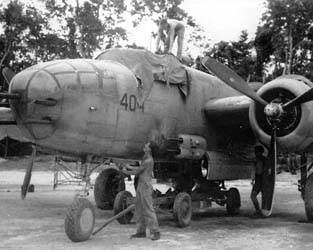Rather than hijack Artik's thread ... I figured I'd add some data here after seeing mention there:
U.S. Marine Corps
World War II
PBJ-1 Bomber
by Bob Jardes
The PBJ-1 [/b]
The why or how the Marine Corps obtained the B-25 for service in World War II is a brief and deep mystery that may never be solved. But four Marine squadrons, equipped with PBJ-1D's did see action ranging from the Solomon Islands to Iwo Jima (1943-1945). The squadrons were VMB-412, VMB-413, VMB-611 and VMB-612. The original training squadron was OTS-8 at MCAS Cherry Point, NC.
The C and D models were first employed in combat, and near the war's end, some J and K models made a brief appearance. At the end of hostilities, the engines of all planes were pulled and shipped to Ewa. The wings were chopped off and the air frames relegated to the junk pile. It was a short-lived span in Marine aviation but, none-the-less, a colorful one.
Handling Characteristics.
The early C and D models handled much like ice wagons, with the gliding characteristics of a free-falling safe. You had to "horse" it around the sky. The H model caught the public's fancy with the 75 millimeter cannon in the nose. However, it proved somewhat less than a spectacular success. The cannon made a one-man airplane of her, which was a mistake. One man can fly it, true, but it takes four hands to get her up and down. The J and K models were a delight. Easy on the controls and responsive to the slightest pressure, they performed more like fighters of the period. Wingovers in the PBJ were great sport. And I'm sure she's been looped by the more courageous.
We split-s'ed her one day from 11,000 feet. Our bomb-slight [sic] mechanic, Corporal Santoro, had taken us on a long and boring ride to check out a seldom-used bombsight. When he finished his tinkering, we gave him a quick and thrilling trip down. From the moment we landed, I never saw him again.
In VMB-611, we festooned the old barracuda with every device known to ordnance and a few of our own design. We had eight 5-inch rockets, thirteen .50 caliber machine guns (nine firing forward), and a bomb load that ranged from fourteen 250-pound bombs to three 1,000 pounders. Someone once noted that we had the fire power of a Navy cruiser broadside. Perhaps. All I know is that the old PBJ-1 could haul it all out of a 4,000 dirt strip with 60-foot palm trees at the end with no sweat.
She would also fly with her tail half shot off. Dave "The Ghost" Chelgren of Phoenix, Arizona is living testimony to that. His laconic radio transmission rings down through the years. "Slow this (formation) down please. She begins to come apart over 135 knots."
Further proof of the PBJ-1's ruggedness came when I hit a tree in a strafing run over the Kibawe Trail in South Central Mindanao - a few miles and a million years from where they discovered the Tasady Stone Age tribe. Too intent on the target, I failed to notice a lone, dead tree. We smacked it hard, about two-thirds of the way up. Five feet lower, and seven mortgages back home would have been immediately paid off. The badly dented cowling was mute evidence the old girl had taken a real shot. We immediately turned for home - 250 miles away. Old Mike Baker 15 purred all the way, never missed a beat. They found pieces of the tree in the aft section of the nacelle. She was down for two weeks, but not before she delivered her crew in one piece.
Missions to Malabang
The ability of the PBJ to get in and out of hairy places is best exemplified in 611's "Missions to Malabang." Philippine guerillas, under command of a questionable U.S. Army major, had secured the perimeter of a large clearing between the sea and the town of Malabang in South Central Mindanao. The guerillas and their flying major requested close air support. We came in from the sea, clearing the beach and landing toward the hills. Who or what was in the hills was not known, but we accepted the report that the guerillas held the position.
The debriefing tent was a shallow depression in the ground. Our mission was to knock out two machine gun positions which were holding up the guerilla advance. The positions were alongside a road, "right over there." (As I recall, the distance was little more than a 5-iron shot away!). Despite a scare that the Japanese had broken through, we pinpointed the location and rushed to the planes. The renowned "small field procedure" of the PBJ came to the fore and we jumped out of there with room to spare. A well-directed run along the road, (dropped eight bombs in a train) disposed of the machine gun nests. A brief strafing and the mission was over.
Other pilots from 611 had similar "missions to Malabang." Two weeks later the U.S. Army communiqué announced the capture of the town. The PBJ's had done their work well.
Lacking in Glamour
The PBJ obviously lacked the glamour of the Corsair, and some of the more exotic breeds such as the "Black Widow," the "Jug," and the "Hellcat." Perhaps that's why aviation chroniclers have shunned her. But her story must be told. Since pilots tend to categorize their birds as women, using such terminology as "sweet," "sleek," "unforgiving," etc., I can only characterize her as a "mother-in-law." Dumpy, dependable, and loud.
http://www.bluejacket.com/usmc_pbj-1.html
Information on Marine Air Group 61:
http://www.mag61.com/